Hampi, once the former capital of Vijayanagar Empire is; now a forgotten empire, a vast open museum of abundant history, architecture and religion; in the middle of the giant rock boulders. Situated at the bank of river Tungbhadra in Northern Karantaka, Hampi is charismatic even in its ruined state. Every year, Thousands of tourists and pilgrims reach to see this poetry in the stones at this UNESCO World Heritage Site.
Hampi or Hampe was a surprised and quick visit for me. I reached there in a sunday morning while returning back from Badami to Hyderabad via Bellary. I reached Bellary in the night and stayed with my friend who was working there at Jindal Steel Plant. I still had Sunday in my hand before reporting to my training center in Hyderabad on Monday. Unaware of its vastness and without any plan, I decided to go Hampi, which is almost 3 hours away from Bellary. Except the Iconic Stone Chariot of Hampi, Bravery Tales of brother duo Harihar and Bukka, and the Greatness of King Krishna Deva Raya, I did not know anything about Hampi. Later, I realized at least four days are required to visit Hampi and at least 10 days to experience Hampi.I visited the area between Virupaksha Temple to Vittala Temple, to be precise I visited Virupaskha Temple, Hemkunta Hills, Achyutaraya Temple and Vittala Temple there alongwith ruins of Hampi Bazaar, Courtseans Street etc. I missed other attractions like The Kings’ balance,Elephant stables, Lotus temple,Hazara Rama Temple etc due to the time restrictions.
1. Virupaksha Temple: When we left the government bus stand at Hampi, this temple seemed the nearest one to walk. It is about 300 meters away from the bus stand. It dates back to the founding of Vijayanagar Empire. The presiding deity of this temple is Lord Shiva. Apart from Shiva,this temple also contains the shrine of Hindu Goddess Bhuvaneshvari and Pampa. It is believed that Lord Shiva consented to marry Devi Pampa in his avatar as Virupaksha. At the entrance, there is a huge 49 meter temple tower. There are lot of carvings of the Hindu god and goddess all around at the temple tower. Interestingly, this temple belong to Lord Shiva, but majority of those carvings belong to Lord Vishnu.
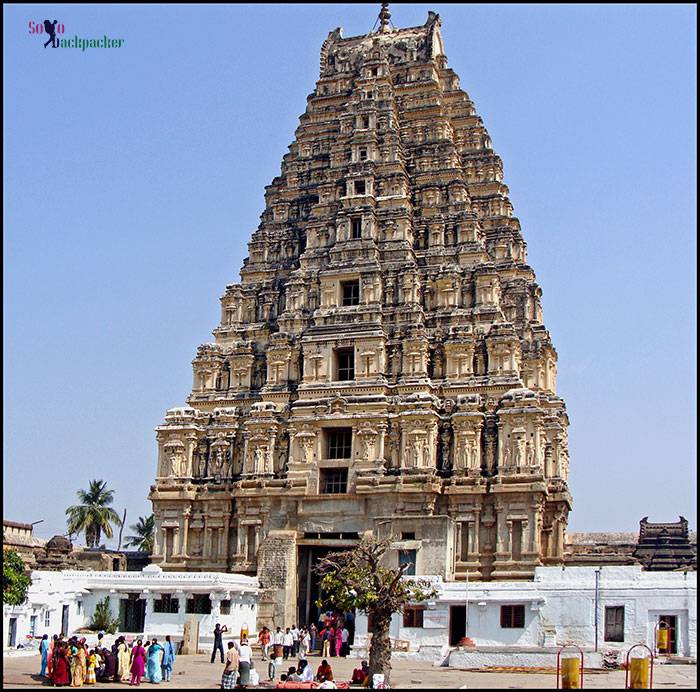
2. Hemakuta Group of Temples: These temple are situated at Hemakuta Hill adjacent to the Virupaksha Temple. Hemakuta Hill seems like a large canvas of stones, where the artist showed all his skills and imagination. From those granite stones they made many temples and other interesting architectures.
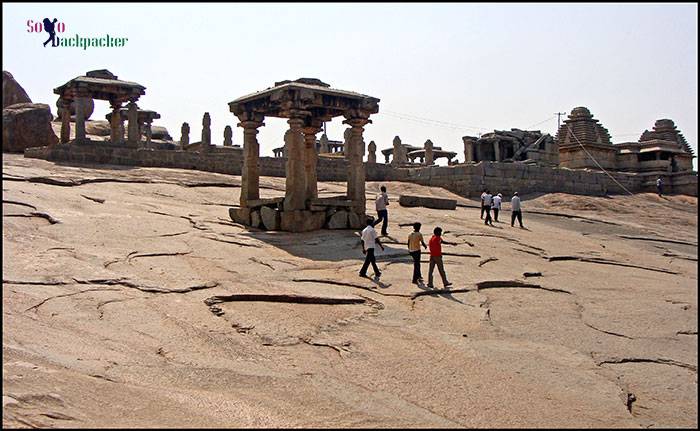
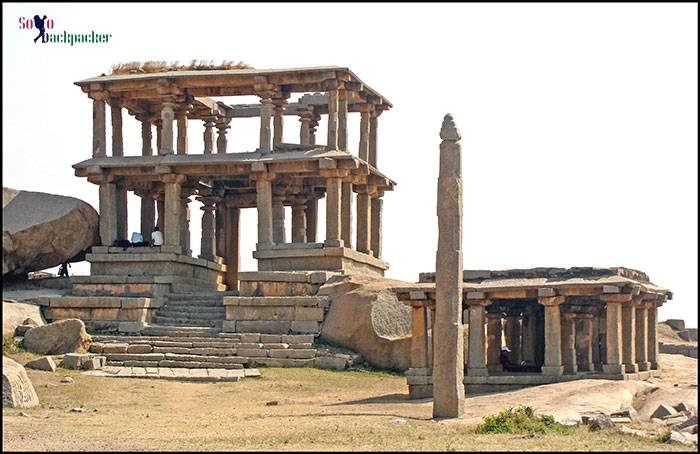
The split face of the boulders is very flat. They used an interesting technique to split these boulders. They made small holes at equal distances in the stones and then dry wooden pegs were driven into those holes.
Then, they continuously poured water into those wooden pegs. Woods soaked the water and expanded gradually. Because of this expansion, these stones gradually split. While roaming around the boulders of this hill, we came across many such series of holes on the boulder surface.
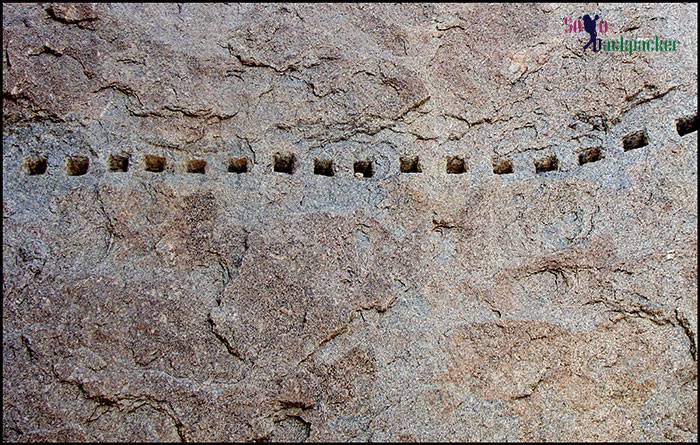
3. Hampi Bazaar: Walking away from Virupaksha Temple towards Vittala Temple, after crossing the bus stand, we reached to the ruins of old Hampi Bazaar (Market) . Actually this 1-km long bazaar starts right in front of Virupaksha Temple and ends at the foothills of Matanga Hill, just in front of EK Shila Nandi. This is also known as Virupaksha Bazaar. Both sides of the street are lined with a series of old pavilions, some of them are two storied. These structures were once part of a thriving market and residence of the nobles and famous for its diamond trading business. Most of the Hampi’s modern day shop and hotels are located on the both sides of this road between Virupaksha Temple and Matanga Hills. Entry to the motor vehicles are regulated on this street, but cycles and mopeds are allowed.
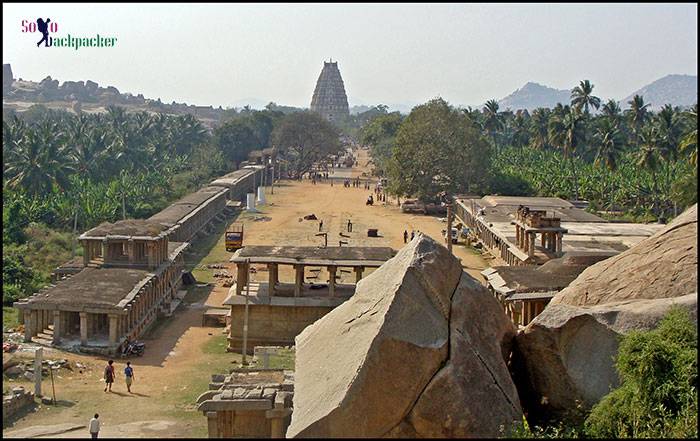
4. Along the River: From the Hampi Bazaar, we moved towards the river. Riverside is also a beautiful view in those boulders of Hampi. People and their vehicles still used the boats to cross the river as there is no bridge. We saw many Coracle Boats lying down there on the bank of the river waiting for the tourists. The river and adjacent area consisted heavy plantation of Palm and Banana and thus offered an incredible greenery in the middle of those giant boulders.
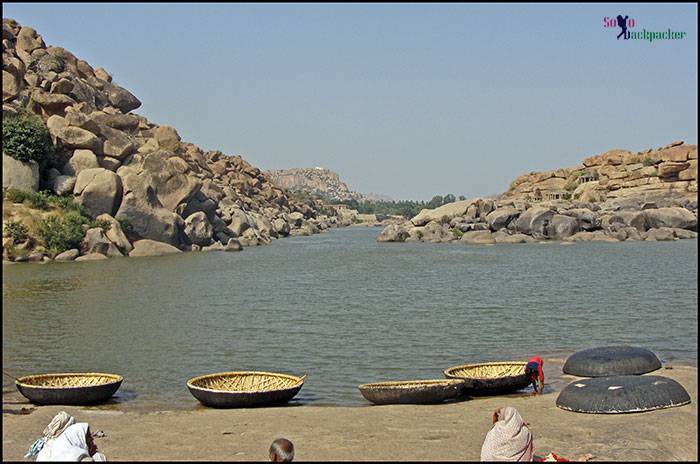
4. One Stone Nandi (Ek Shila Nandi): Returning back from the river, we turned towards the structure of One Stone Nandi. There is a huge structure of Nandi, the respectable bull of Lord Shiva, right after the Hampi Bazaar at the foothill of Matanga Hill. This is made by a single stone with absolute precision and patience. We Climbed-up on the hill little beyond the Nandi statue, and then got a splendid view of Hampi Bazaar and Viupaksha Temple.
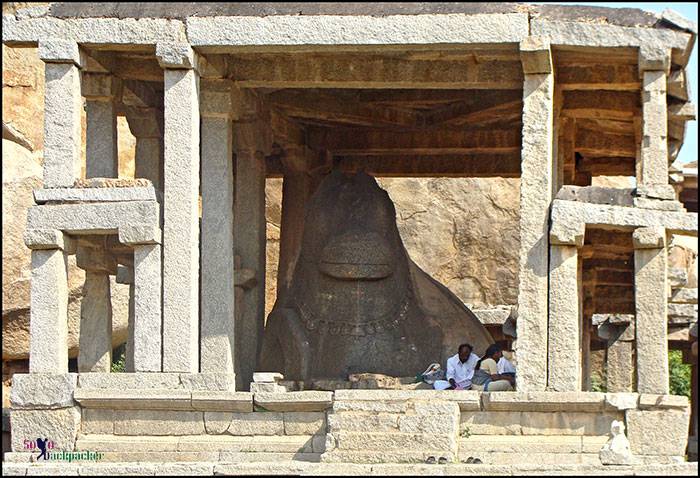
5. Achyutaraya Temple: Moving further to the Matanga Hill, after crossing a major boulder area, we reached at Achyutaraya Temple on the other side of the hill. Built in AD 1534, this temple is the finest structure of the Vijayanagara Empire Temple Architecture. The temple dedicated to Lord Tiruvengalanatha, a form of Vishnu , was constructed by a high officer in King Achyuta Deva Raya’s court and hence the name. The main shrine is located at the centre of two rectangular concentric courtyards. In the compound of this temple, we spotted some of the finest carved pillars in Hampi.
6. Courtsean’s Street: In front of the Achyutaraya Temple, there is a row of ruined pavilions on the both sides. During the prime time of the empire, this was a thriving market of gems, pearls, ivory and the likes. Roughly half a kilometer long and about 50 meters wide, this street was once thronged by merchants even from far places.
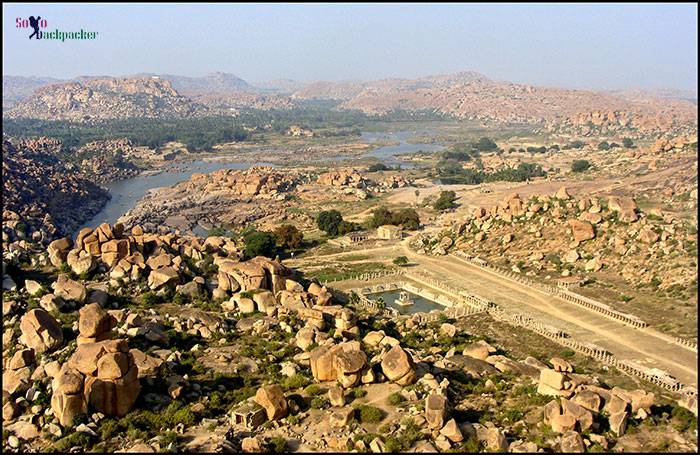
A large rectangular tank associated with Achyuta Raya’s temple is located at the northwest end of the street. Though collapsed, interesting remains of a pillared pavilion can be traced around this stepped tank.After this tank, walking further on Courtsean’s Street could took us to the riverside area.
7. On the top of Matanga Hill: I was walking from last 5 hours in the ruins of Hampi, but the iconic stone chariot was still nowhere in sight. From the stepped tank near Courtsean’s Street, we returned towards Achyutaraya Temple. There we saw some foreigners climbing on Matanga Hill. We followed them and reached at the top of Matanga Hill. There was nothing interesting there at the top except at an old structure. But from there we could see the aerial view of Hampi all around. It was awesome. Boulders dominated the whole area around Hampi, Palm and Banana Plantation at several places looked like an Oasis and at that height of the ruins of the Vijayanagar Empire, we saw the dizzying scale of the Hindu conquerors’ glory. This is the best place to view the sunset in the evening.
I showed the picture of stone chariot to some local kids who was there at the top. The showed me the way to Vittala Temple from there, that houses the stone chariot.
8. Vittala Temple: I descended down the hill and again moved towards the Courtsean’s Street. After one km walk from the street, we reached to Vittala Temple Complex. This is first place at Hampi, where we bought an entry ticket of INR 10. In fact it is the center of Hampi’s attractions.
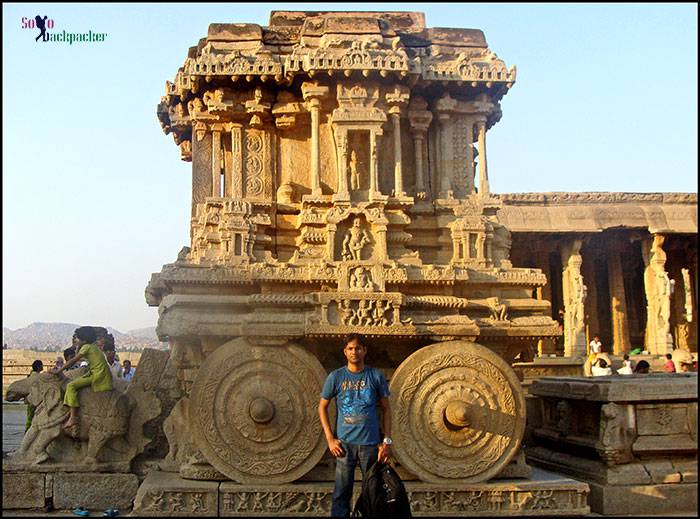
The temple is built in the form of a sprawling campus with compound wall and gateway towers. There are many halls, pavilions and temples located inside this campus.Vittala, after whom the temple is known, is a form of lord Vishnu. The iconic stone chariot was also inside this temple complex. The pillars and walls of this temple complex is decorated by one of the most beautiful carvings in the history. Finally, with the visit of Vittala Temple Complex, we concluded our single day trip to Hampi.
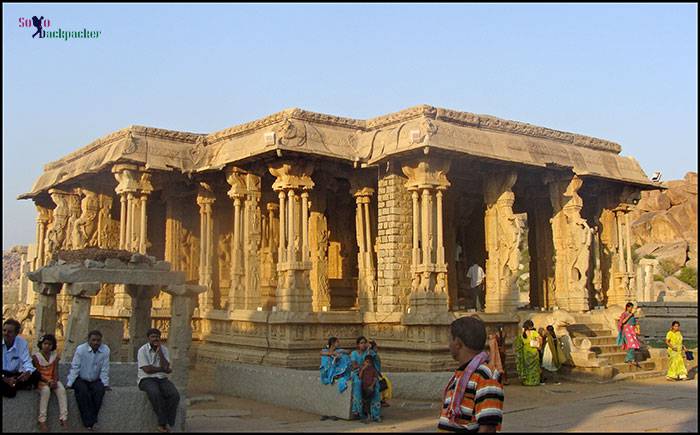
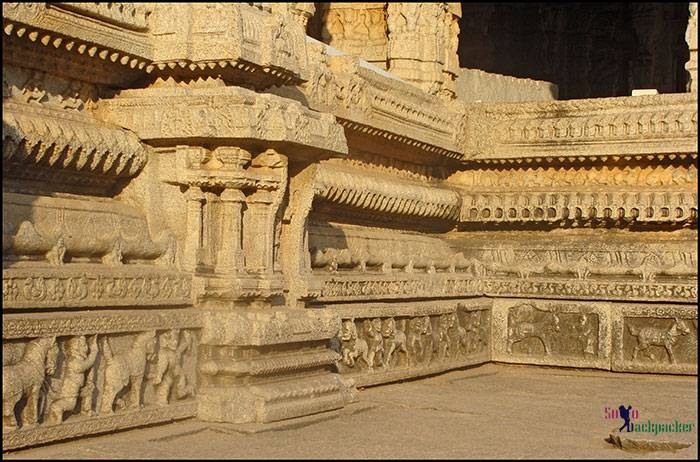
Hampi has a lot to offer. Old stone structures, religious and historical monuments, old traditional markets, splendid ruins with finest example of medieval Indian architecture..Hampi is still fresh in my memory and I wish to reach there soon.


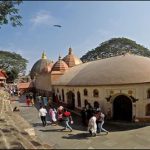
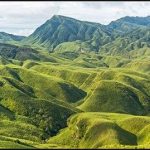
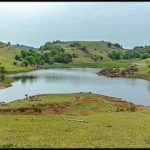
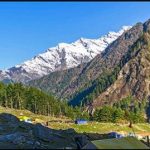
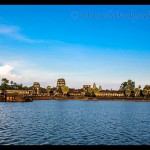
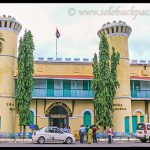
Interesting account. I am a senior citizen and find it difficult to walk long distances and over undulating or rough terrain. Would it be advisable for me to go to Hampi at all?
Hampi is good and approachable for everyone. If you find it tough to climb on the hills, just stick to the plain areas. Most beautiful areas don’t require too much physical activities. You should go there definitely. No problem at all. Have a nice trip.
How much time did it take to see all that you have listed here excluding the bazaar and the river ride? Can all this be covered in 6-7 hrs without rushing?
It’s possible depending on the starting place of your journey.
I am planning a visit to Hampi this weekend, I came across your blog and it helped me get a better idea to plan my trip. Thanks for sharing your experience. The pictures are beautiful so is your account
Thank you for the appreciation. You too have a nice blog. Looking forward to hear your stories from Hampi.
how did you tour the hampi by moped , bus or rental.
Hi, I took a bus from Hospet to Hampi. In Hampi area, I walked from one place to the another.
Just increased my desire to visit these temples and learn more about chalky a dynasty
Very well quoted .. Though I never been to Hampi.. but it felt like I was seeing through your text. Much Appreciated!!
Thank You very much
Amazing pictures and description. I have come back today from my 3 day trip to Hampi. It was one of its kind experience.
Hampi looks amazing.
Lovely captures and article.